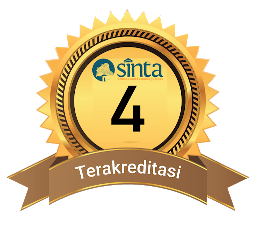Pengembangan Media Pembelajaran Kimia Berbasis Web: Meningkatkan Literasi Siswa Tentang Larutan Elektrolit-Nonelektrolit
DOI:
10.29303/cep.v5i2.3686Published:
2022-11-30Issue:
Vol. 5 No. 2 (2022): Edisi NovemberKeywords:
Development, Learning media, Web, Chemistry, Electrolyte SolutionArticles
Downloads
How to Cite
Abstract
Tujuan dilaksanakan penelitian untuk melihat kelayakan media pembelajaran yang berbasis web untuk meningkatkan minat literasi siswa khususnya pada materi kimia yang berfokus pada larutan elektrolit dan non elektrolit. Peneliti menggunakan metode penelitian R&D (Research and Development). Peneliti juga memakai desain one group pretest and posttest, dimana peneliti menggunakan 34 siswa XI MIPA 3 SMA Negeri 21 Surabaya yang sudah mempelajari materi larutan kimia tersebut. Lembar telaah, lembar penilaian, angket respon, lembar validasi, pretest, serta posttest menjadi instrumen penting dalam penelitian ini. Hasil telaah dalam penelitian ini, web sudah sesuai dan dapat diujicobakan. Tingkat kevalidan Web ini dalam segi konstruk mencapai 84%. Sementara dalam segi isi,tingkat kevalidan web ini dapat mencapai 84,16%. Media ini juga mencapai presentase 81,42% untuk respon menurut 28 murid yang sudah mencoba media web ini. Keberhasilan penelitian ini dilihat dari perbedaana antara posttest dan pretest peserta. Nilai posttest peserta mendapatkan nilai 73% sedangkan posttest mendapatkan nilai 100%. Sehingga, media pembelajaran yang diteliti tergolong efektif.
References
Bagunda, F. (2020). Penggunaan Media Pembelajaran Video Untuk Meningkatkan Hasil Belajar Siswa Kelas X Pada Mata Pelajaran Pendidiakn Agama Islam Di SMA Negeri 1 Modayag. Skripsi: Institut Agama Islam Negeri (IAIN) Manado.
Cahyana, U., Supatmi, S., Erdawati, & Rahmawati, Y. (2019). Pengaruh Pembelajaran Berbasis Web dan Kemandirian Belajar Terhadap Literasi Ilmiah Siswa Mata Kuliah Kimia. Jurnal Internasional Pengajaran, 3(2):127-136
Chandarsegaran, A., Treagust, D., & Mocerino, M. (2007). The development of a two-tier multiple-choice diagnostic instrument for evaluating secondary school students' ability to describe and explain chemical reactions using multiple levels of representation. Chemistry Education Research and Practice, 293-307.
Chittleborough, G., & Treagust, D. F. (2007). The modelling ability of non-major chemistry students and their understanding of the sub-microscopic level. Chemistry education research and practice, 8(3), 274-292.
Choi, K., Lee, H., Shin, N., Kim, S.-W., & Krajcik, J. (2011). Re-conceptualization of scientific literacy in South Korea for the 21st century. Journal of Research in Science Teaching, 670-697.
Fauzi, T. (2015). Pengembangan Bahan Ajar Berbasis Web Untuk Meningkatkan Literasi Sains Siswa Pada Konsep Ekologi Kelas X MIA di SMA Negeri 3 Sumedang.
Hamdani. (2011). Strategi belajar mengajar. Bandung: CV. Pustaka Setia
Kemendikbud. (2013). Permendikbud Nomor 65.
Lutfi, A., Suyono, Erman, & Hidayah, R. (2019). Edutainment With Computer Game as a Chemistry Learning Media. Jurnal Penelitian Pendidikan Sains, 1684-1689.
PISA (2018). Assessment and Analytical Framework.
Shwartz, Y., Ben-Zvi, R., & Hofstein, A. (2006). The use of scientific literacy taxonomy for assessing the development of chemical literacy among high-school students. Chemistry education research and practice, 7(4), 203-225.
Toharudin, U., Hendrawati, S., & Rustaman, A. (2011). Membangun Literasi Sains Siswa. Bandung: Humanoira.
Trefil, J., Hazen, & M, R. (2010). Sciences :an integrated approach, Ed. 6. John Wiley & Sons.
Author Biography
Tariqa Sadiah, Universitas Negeri Surabaya
License
Copyright (c) 2022 Tariqa Sadiah, Rusly Hidayah

This work is licensed under a Creative Commons Attribution-ShareAlike 4.0 International License.
Authors who publish with Chemistry Education Practice agree to the following terms:
- Authors retain copyright and grant the journal right of first publication with the work simultaneously licensed under a Creative Commons Attribution License 4.0 International License (CC-BY-SA License). This license allows authors to use all articles, data sets, graphics, and appendices in data mining applications, search engines, web sites, blogs, and other platforms by providing an appropriate reference. The journal allows the author(s) to hold the copyright without restrictions and will retain publishing rights without restrictions.
- Authors are able to enter into separate, additional contractual arrangements for the non-exclusive distribution of the journal's published version of the work (e.g., post it to an institutional repository or publish it in a book), with an acknowledgement of its initial publication in Chemistry Education Practice.
- Authors are permitted and encouraged to post their work online (e.g., in institutional repositories or on their website) prior to and during the submission process, as it can lead to productive exchanges, as well as earlier and greater citation of published work (See The Effect of Open Access).






